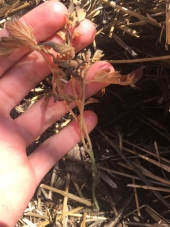





I choose...to be the best me I can be, to be the strongest me I can be, to learn the most I can. I don't know what comes next. But I'm gonna go into it balls to the walls, flames in my hair, and full speed ahead.
 9
9




Susan Mené wrote:
I have raised beds. Do I have to replace all the soil?
Some beds are near the woods and I have found diseased leaves falling into my garden. I can relocate them, but not far enough to completely eliminate the risk.
I have purchased a mix with "mycorrhizal fungi, trichoderma and a diverse mix of bacterial species" to inoculate the soil with , but I have also heard of covering beds with black plastic to sterilize, which would negate the inoculant. Also, I think it is too late in the season (zone 7) to get and extended period of hot weather. My compost isn't ready yet to introduce to the soil.
Do I toss this soil to an unused pile in my back yard and start over (expensive)? In the next week, I plan to plant a few varieties of garlic to overwinter,; should I just give it a try after adding the inoculant?
Shaking my head. Despite the difficulties and come what may, I still love all of this lifestyle.

"Study books and observe nature; if they do not agree, throw away the books." ~ William A. Albrecht
 3
3




 3
3




Iterations are fine, we don't have to be perfect
My 2nd Location:Florida HardinessZone:10 AHS:10 GDD:8500 Rainfall:2in/mth winter, 8in/mth summer, Soil:Sand pH8 Flat








 3
3




I choose...to be the best me I can be, to be the strongest me I can be, to learn the most I can. I don't know what comes next. But I'm gonna go into it balls to the walls, flames in my hair, and full speed ahead.

 1
1












 1
1




[/quote, but we just started, we are still learning our own habits and deficiencies as we learn about the plants. I am trying to keep my head up and count my losses as lessons learned.
So true. It's all unfolding bit by bit. It may seem a little poetic, but my view of the big picture widens as the intricate weave of the millions of interwoven threads sharpens.
On the practical side, drip/soaker irrigation, whatever the cost, is side by side with mulch on the top of my list. Oh, and labeling my saved seeds.
I have to say companion planting really helps the garden rock n' roll.
I choose...to be the best me I can be, to be the strongest me I can be, to learn the most I can. I don't know what comes next. But I'm gonna go into it balls to the walls, flames in my hair, and full speed ahead.












I choose...to be the best me I can be, to be the strongest me I can be, to learn the most I can. I don't know what comes next. But I'm gonna go into it balls to the walls, flames in my hair, and full speed ahead.








 1
1




I choose...to be the best me I can be, to be the strongest me I can be, to learn the most I can. I don't know what comes next. But I'm gonna go into it balls to the walls, flames in my hair, and full speed ahead.












I choose...to be the best me I can be, to be the strongest me I can be, to learn the most I can. I don't know what comes next. But I'm gonna go into it balls to the walls, flames in my hair, and full speed ahead.

|
He's giving us the slip! Quick! Grab this tiny ad!
The new purple deck of permaculture playing cards
https://www.kickstarter.com/projects/paulwheaton/garden-cards
|


